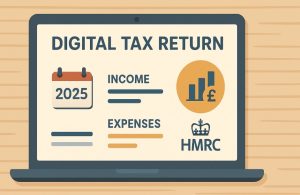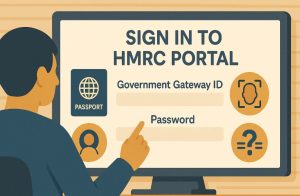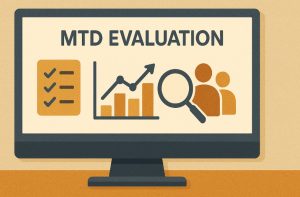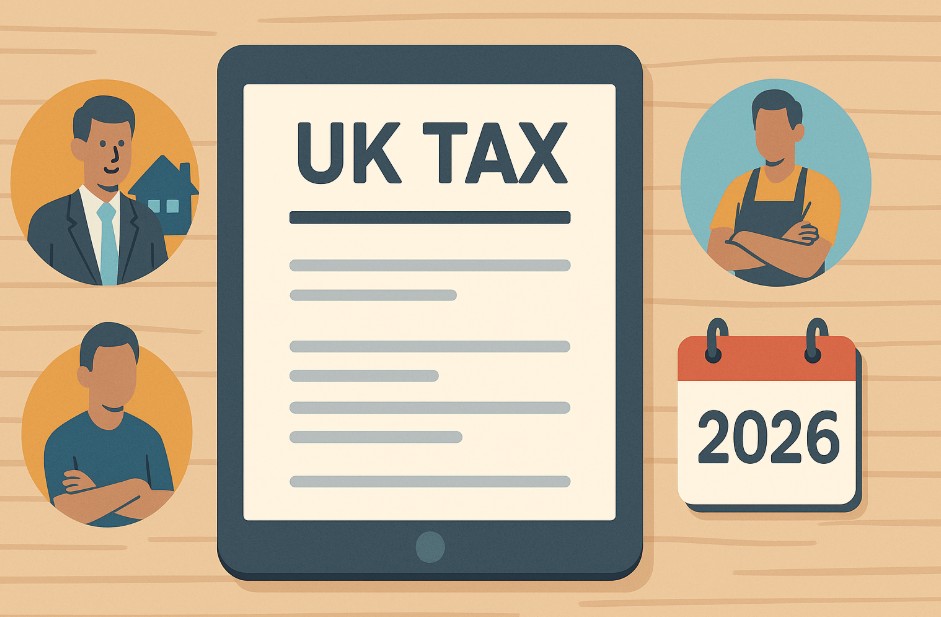Making Tax Digital for Income Tax (MTD for ITSA) is transforming how UK sole traders and landlords manage their tax obligations. Introduced by HMRC, this digital-first approach aims to simplify compliance and reduce errors through regular online reporting.
With phased deadlines starting in 2026, understanding who must comply and when is crucial. This guide explores the essentials of MTD for ITSA, helping individuals prepare for the shift to digital record-keeping and avoid potential compliance issues in the years ahead.
What Is Making Tax Digital for Income Tax?

Making Tax Digital for Income Tax is HMRC’s new approach to handling tax returns for sole traders and landlords.
It requires those affected to use compatible software to record and submit their income and expenses digitally.
The system is designed to help individuals:
- Create, store, and correct digital records of income and expenses
- Submit quarterly updates directly to HMRC using approved software
- File their annual tax return and make any tax payments by 31 January following the end of the tax year
The intention behind this change is to reduce errors, modernise tax reporting, and help taxpayers better manage their records throughout the year rather than relying on year-end reconciliation.
Who Should Sign Up and When?
Currently, signing up for Making Tax Digital for Income Tax is voluntary. HMRC is encouraging participation from individuals who are willing to help test the service or prepare for full rollout.
You may choose to sign up:
- For testing purposes
- Early, to get used to the process before it becomes mandatory
From 6 April 2026, Making Tax Digital will become mandatory for certain individuals based on income. Whether you need to sign up will depend on your total annual income from self-employment and property.
| Total Annual Income | Mandation Status | Effective Date |
| Over £50,000 | Mandatory | From 6 April 2026 |
| £30,000 to £50,000 | Mandatory | From 6 April 2027 |
| Under £30,000 | Voluntary | Not yet mandated |
You can use HMRC’s online tool to determine whether and when you need to sign up. If you use an accountant or tax agent, they can also register you on your behalf.
If you sign up voluntarily, you’ll still need to submit a regular Self Assessment tax return for the 2024–2025 tax year.
Who Can Sign Up Voluntarily?
Voluntary participation is allowed for individuals who meet the following criteria:
- UK resident
- Have a National Insurance number
- Personal details are up to date with HMRC
- Submitted at least one Self Assessment tax return
- Are up to date with their tax obligations, with no outstanding liabilities
- Use an accounting period of either 6 April to 5 April or 1 April to 31 March (if supported by software)
Who Cannot Sign Up Voluntarily?
Some individuals are not currently eligible to sign up voluntarily. These include those who:
- Have a payment plan in place with HMRC
- Are partners in a business partnership
- Claim Blind Person’s Allowance or Married Couple’s Allowance
- Are insolvent or have been declared bankrupt
- Are MPs, ministers of religion, or Lloyds underwriters
- Have income from trusts, shared lives schemes, or fostering
- Are subject to a tax compliance enquiry
- Use income averaging due to fluctuating profits (e.g. farmers, artists, writers)
- Are signing up on behalf of someone else without being a registered agent
What You Need Before Signing Up?

To begin using Making Tax Digital for Income Tax, you must have access to software that is approved and compatible with HMRC’s systems. It’s important to check that the software meets your business needs, especially if you use a non-standard accounting period.
You will need:
- Your National Insurance number
- The date you started your business or began receiving property income
- Your accounting method (cash basis or traditional accounting)
- The tax year you plan to start using MTD for Income Tax
If you are a sole trader, additional information is required:
- Business name (as used on invoices)
- Business address
- Nature of your trade
If you have income from more than one self-employed business or from both self-employment and property, you’ll need to sign up each source individually for Making Tax Digital.
Your Accounting Period Options
There are two acceptable accounting periods for MTD for Income Tax:
- 6 April to 5 April — the standard tax year
- 1 April to 31 March — a commercial accounting year that aligns with most business accounting software
If you choose to use the 1 April to 31 March accounting period, your software must support it. You must also:
- Select calendar update periods in your software before your first submission
- Make an end-of-year adjustment to include income and expenses from 1 April to 5 April
HMRC’s New Penalty System
With the rollout of Making Tax Digital, HMRC is also introducing a new penalties regime based on the timeliness of reporting and payment.
| Missed Obligation | Penalty Application |
| Quarterly update (during testing) | No penalty applied |
| Tax return submission | Penalties apply |
| Tax bill payment | Penalties apply |
HMRC will write to individuals to confirm once they become subject to the new penalty system. During the testing phase, there is flexibility, but once MTD becomes mandatory, the full penalty regime will be enforced.
How to Sign Up for Making Tax Digital for Income Tax?

To sign up, you’ll need the Government Gateway user ID and password you used to register for Self Assessment. During the registration process, you may also be asked to verify your identity through one of the following methods:
- Using a mobile phone app that compares your face with your passport or driving licence
- Answering security questions based on HMRC’s records (passport details, payslips, credit reference, etc.)
Once your identity is verified and eligibility confirmed, you’ll be enrolled in the Making Tax Digital for Income Tax service.
How Does MTD for ITSA Work in Practice?
Once a taxpayer falls within the MTD threshold, they must begin using MTD-compatible software. The software enables:
- Keeping digital records of income and expenditure
- Submitting four quarterly updates to HMRC during the tax year
- Sending a final declaration at the end of the year to confirm figures
The quarterly update deadlines are fixed and do not change year to year. Updates must include cumulative income and expenses, with corrections made in subsequent returns if needed.
The end-of-year finalisation (known as the End of Period Statement) allows for adjustments, such as capital allowances or accounting changes, to ensure the correct amount of tax is calculated.
The use of bridging software is permitted for those using spreadsheets, although HMRC encourages the adoption of fully integrated digital tools.
What Are the Legal Requirements for MTD Compliance?

MTD for ITSA is underpinned by legislation in the Finance (No. 2) Act 2017. Specifically:
- Section 60 introduces Schedule A1 into the Taxes Management Act 1970, setting the framework for MTD for ITSA
- Section 61 introduces Schedule 14, enabling necessary amendments to existing tax legislation
- The Appointed Day Regulations 2021 set the enforcement date as 6 April 2024 for the legal framework
To comply with MTD, affected individuals must:
- Digitally preserve records of business income and expenses
- Submit quarterly updates using approved software
- Send the annual final declaration through MTD software
- Ensure updates are sent on the dates specified in HMRC regulations
Are There Any Exemptions to MTD for Income Tax?
Exemptions are available for taxpayers who genuinely cannot engage with digital systems. These include:
- People with disabilities
- Those with no or unreliable internet access
- Individuals whose religious beliefs prevent them from using electronic systems
Taxpayers who are currently exempt from MTD for VAT will also be exempt under MTD for ITSA. HMRC has designed a straightforward exemption application process, available via:
- Online form submission
- Written requests
- Phone applications
Once granted, an exemption removes the obligation to maintain digital records or submit updates electronically.
HMRC is working with inclusion and accessibility groups to ensure the system works for everyone. It continues to develop support models including:
- Agent assistance
- Extra Support services
- Accessible content on GOV.UK
- Free digital training resources and webinars
What Are the Benefits of Adopting MTD for Income Tax?
Despite concerns over transition costs and administrative changes, adopting MTD can result in measurable benefits for businesses and individuals.
Some of the long-term advantages include:
- Reduced risk of errors in record keeping and reporting
- Improved accuracy and timeliness of tax submissions
- Easier year-end reconciliation and tax planning
- Digital tools saving time on manual paperwork
- Better visibility into business finances through real-time data
For accountants and tax agents, MTD can streamline collaboration with clients, especially when clients use software that facilitates automatic data sharing and real-time reporting.
The government anticipates that, over time, the administrative burden will decrease as taxpayers become familiar with digital processes and begin to use automation features in software tools.
How Will HMRC Monitor and Evaluate MTD for ITSA?

HMRC has outlined a detailed plan to evaluate the effectiveness of MTD for ITSA through to 2029. This plan includes the use of pilot schemes, research studies, and behavioural analytics.
Evaluation will be conducted using:
- Public beta testing scheduled for 2025
- Surveys and social research studies to understand taxpayer experience
- Self Assessment data analysis to measure compliance rates and revenue impact
- Annual reviews and published findings to ensure transparency
The goal is to ensure the system delivers benefits while identifying areas where further simplification or support may be needed.
This monitoring process will also help HMRC decide when and how to expand MTD to additional taxpayer groups such as partnerships or those earning below £30,000.
Conclusion
Making Tax Digital for Income Tax represents a major change for sole traders and landlords, requiring proactive preparation and the adoption of digital tools.
By understanding the income thresholds, deadlines, and legal requirements, affected individuals can ensure a smooth transition.
Whether you’re mandated to comply or considering voluntary participation, now is the time to explore compatible software, assess your readiness, and seek support if needed.
With careful planning, MTD can improve efficiency and accuracy in managing your tax affairs.
Frequently Asked Questions About MTD for ITSA
What is qualifying income for MTD?
Qualifying income refers to gross income from self-employment and property, excluding any non-taxable or investment income.
Can I still use spreadsheets under MTD?
Yes, but only if you use bridging software that links your spreadsheet to HMRC’s systems.
Do I need to register separately for MTD?
Yes, you’ll need to sign up for MTD through your compatible software or via HMRC once you’re eligible.
Will HMRC provide MTD-compatible software?
No, but HMRC maintains a list of approved MTD software providers, including some free options for small businesses.
What happens if I miss a quarterly update?
Failure to submit updates on time could result in penalties under HMRC’s points-based late submission regime.
Is MTD mandatory for partnerships?
Not yet. MTD for partnerships will be introduced at a future date, but is not included in the 2026 or 2027 timelines.
Can I opt out of MTD if I prefer paper records?
Only if you meet the criteria for digital exclusion and are granted an exemption by HMRC.








